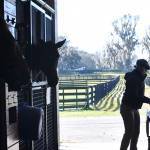Colic in Horses: Feed Dry Matter for Swift Recovery

Colic has a high mortality rate and is currently ranked as the third most common cause of death in horses. Without surgical intervention, an estimated 7-10% of horses with colic either die or are euthanized.
“While many factors may play a role in why horses develop colic, diet certainly ranks high on the list,” noted Kathleen Crandell, Ph.D., a Kentucky Equine Research nutritionist.
“Diets high in concentrates and low in forage result in rapid feed consumption, which has multiple undesirable effects. In addition, low-fiber diets cause changes in the intestinal microbiome, which can alter the fermentation process and negatively affect metabolic processes,” Crandell explained.
Feeding horses after colic can be tricky, but the goal is to re-establish normal gut function, including restoration of the intestinal microbiome. Various post-surgery feeding practices have been explored in the past to determine beneficial methods of re-introducing feed after colic. In a recent study*, veterinarians reviewed the medical records of horses undergoing colic surgery and analyzed various parameters with regards to feeding postoperatively. Examples of such parameters included:
- Time (in hours) to the first meal;
- Percent of dry matter intake as forage (hay and/or grass) per body weight in the first and second days after surgery;
- Percent of total dry matter intake based on all the feed consumed (forages and concentrate) per body weight on the second and fourth day after surgery (48–72 hr and 96–120 hr, respectively); and
- Time (in days) to reach minimum dry matter intake, which was defined as
10 g dry matter/kg body weight.
“This study found that horses with short recoveries consumed a higher percent of dry matter as forages in the first 24 hours postoperatively and reached the minimum dry matter intake in a shorter period,” summarized Crandell.
In addition, time to first feeding had a positive association with the length of recovery in that earlier feeding was associated with shorter recovery times.
“Appropriate feeding strategies help minimize the development of colic and facilitate recovery after gastrointestinal upset. Consult with a Kentucky Equine Research nutritionist to tweak your horse’s diet to provide both the forage and energy your horse needs,” Crandell advised.
*Valle, E., G. Giusto, L. Penazzi, et al. 2019. Preliminary results on the association with feeding and recovery length in equine colic patients after laparotomy. Journal of Animal Physiology and Animal Nutrition (Berl) 103(4)1233-1241.








